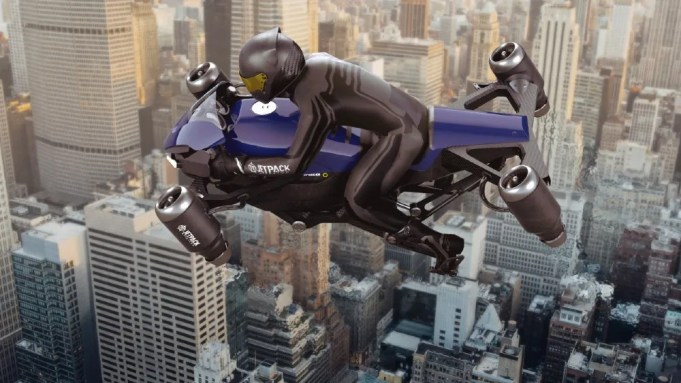The intriguing “flying motorcycle,” formerly known as , is racing ahead in its development with a new name—the Razor. “There were just too many things out there calling themselves ‘Speeder,’” says David Mayman, the CEO of both Jetpack Aviation and Mayman Aerospace.
The name change comes as Mayman and company temporarily pivot away from the jet bike and focus on its autonomous, high-speed VTOL, also called the Razor. The military-designated super-drone uses eight small jet turbines, mounted two per corner, to produce speeds above 400 knots, flying to a 20,000-foot ceiling, with a 200-mile range. This unmanned predecessor to what Mayman envisions as his flying motorcycle uses the same tech but offers a more appealing business proposition for his firm.
Inventor of the flying motorcycle and backpack jetpack, Mayman Aerospace has moved into military mega-.
Mayman Aerospace
“Electric drones can carry 20 to 50 pounds and fly 100 mph,” Mayman says. “We can carry 100 to 500 pounds and fly at speeds approaching 500 mph.” The unique combination of capacity and speed has caught the government’s attention, including development deals with the Department of Defense.
Working prototypes are already aloft, and Mayman expects to complete testing in Q3 with delivery of the initial version to the DOD in Q1 2025. That model won’t hit the range and speed numbers Mayman cites—at least not yet. But subsequent iterations will. “Realistically, I expect military certification next year, then two years of building flight hours,” he says.

The new drones will develop the technology for the jet bike.
Mayman Aerospace
Besides military use, Mayman says the Razor is “perfect for disaster relief. Hurricane, tornado, even wildfire, anywhere you need to ferry supplies in and out very quickly.” He also foresees a business market, especially for companies that have to move heavy equipment back and forth or reach remote locations in any weather conditions, like oil rigs or construction projects.
Accelerating the Razor’s development has had other consequences, which are negative to sci-fi lovers of . The new products have forced Mayman to shelve his well-publicized . “We’re not focusing on it at the moment,” he says. “We have so many contracts with the DoD, it’s impossible to do it all, so we’re focusing on hitting our commitments on safety, certification and flight hours.”

One of the casualties of the pivot into drones is the jetpack, which Mayman Aerospace will discontinue.
Mayman Aerospace
The James-Bond-like jetpack allowed trained users to soar to 10,000 feet and run at 120 mph for six to 10 minutes. The company offered anyone with a checkbook and a dream a chance to train on the device at its California base. To date, Mayman had built 16 of them and sold five to private owners. Now, those opportunities have been grounded.
The good news for anyone who wants to be a real-life Ironman is that U.K.-based Gravity Industries is offering a similar jetpack called the to interested clients.
But the loss of Mayman’s jetpack is offset by the tantalizing prospect of a flying motorcycle. Mayman says the logistics and safety of putting a someone on board are still fuzzy, but remain part of the long-term plan. A ridable Razor would have reduced speed and altitude limits and likely cost between $250,000 and $300,000. “It wouldn’t be before 2028,” he says. “By then, it’s certainly possible.”




